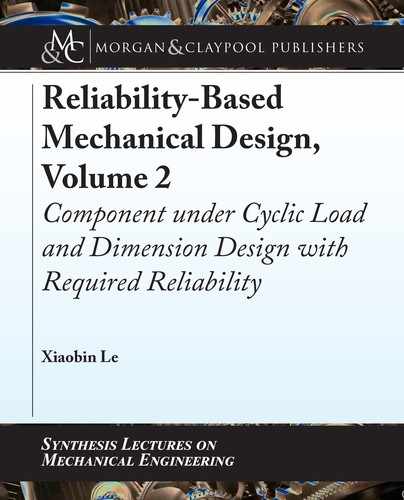
3.5. SUMMARY 201
Table 3.71: e iterative results of Example 3.28 by the modified R-F method
Iterative #
K
0
*
k
a
*
K
f
*
K
f
*
s
d
*
|∆d
*
|
1 1.43E+18 0.9053 2.0337 1.6552 1.541001
2 1.34E+18 0.9053 2.0337 1.6552 1.544186 0.003186
3 1.34E+18 0.9053 1.567166 1.751261 1.470725
0.073461
4 1.34E+18 0.9053 1.581338 1.771731 1.473547
0.002822
5 1.34E+18 0.9053 1.581675 1.77091 1.473636
8.86E-05
program flowchart shown in Figure 3.3 to compile a MATLAB program. e iterative results
are listed in Table 3.71.
According to the result obtained from the program, the mean of the diameter with a
reliability 0.99 is
d
D 1:474
00
: (k)
erefore, the diameter of the shaft with the required reliability 0.99 under the specified loading
will be
d D 1:474 ˙ 0:005
00
:
3.5 SUMMARY
For mechanical component design, we have selected material and have the loadings which are
specified by the design specifications. e reliability of a component links the material properties,
loading, and dimension together through a limit state function. When the reliability is specified,
we can use this limit state function to determine the dimension of the component uniquely.
For mechanical component dimension design, there are several dimensions-dependent
parameters. For a component under static loading, the dimension-dependent parameter is the
stress concentration factor. For a component under cyclic loading, the dimension-dependent
parameters will be the fatigue stress concentration factor and the size modification factor. For
mechanical component design, typically, we always have a sketch of the assembly which are based
on the required functions of the assembly and components. erefore we have the rough shape
of the component and the possible fillet radius on the stress concentration area if there is a stress
concentration. We can conduct preliminary design to select the static stress concentration factor
and the size modification factor which has discussed in Section 3.2.1. When the fillet radius
in the stress concentration is provided, we can further calculate the fatigue stress concentration
factor for fatigue design, which is discussed in Section 2.6. During the iterative process, these
202 3. THE DIMENSION OF A COMPONENT WITH REQUIRED RELIABILITY
dimension-dependent parameters need to be updated in each iterative step by the newly available
dimension.
When the limit state function of a component under a specified loading is established, and
initial dimension-dependent parameters are selected through the preliminary design, we can use
four different computational methods to iteratively determine component dimension with the
required reliability under the specified loadings. ese four methods are as follows.
• e FOSM method. When all random variables in the limit state function are normal
distributions, the FOSM method provides an equation to link the reliability index ˇ with
the means and the standard deviations of all normally distributed random variables. In
this equation, the only one unknown is the dimension and so can be solved. is is an
approximate result. is method has been discussed in Section 3.2.2.
• e modified H-L method. When all random variables in the limit state function are
normal distributions, the modified H-L method can be used to determine the component
dimension iteratively. e detailed procedure and the program flowchart of the modified
H-L method have been discussed in Section 3.2.3.
• e modified R-F method. When there is at least one non-normal distribution in the
limit state function, the modified R-F can be used to determine the component dimension
iteratively. e detailed procedure and the program flowchart of the modified R-F method
have been discussed in Section 3.2.4.
• e modified Monte Carlo Method. For any type of distribution in a limit state func-
tion, the modified Monet Carlo method can always be used to determine the component
dimension iteratively. is method might take a little longer computing time to get the
result when it is compared with the modified H-L and modified R-F methods. e de-
tailed procedure and the program flowchart of the modified Monet Carlo method have
been discussed in Section 3.2.5.
e dimension design of the component under static loading is discussed in Section 3.3.
Several examples are provided and discussed, including bars under axial loading, pins under di-
rect shearing, shafts under torsion and beams under bending, and components under combined
loadings.
It is difficult to use the P-S-N curves approach to conduct the dimension design because
stress is the dimension-dependent, and the corresponding P-S-N curves could not be selected.
erefore, the dimension design of component under cyclic loadings is based on the K-D prob-
abilistic fatigue damage model in this chapter and is fully demonstrated and discussed in Sec-
tion 3.4. Several examples are presented including bars under cyclic axial loadings, pins under
cyclic direct shearing loading, shafts under cyclic torsion loadings, beam under cyclic bending
loadings, rotating shaft under cyclic combined-bending-torsion loading.
..................Content has been hidden....................
You can't read the all page of ebook, please click here login for view all page.
